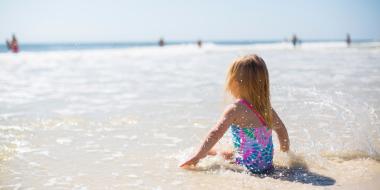Kids are spending more time indoors than any other generation. They spend ten times more time inside, in front of a TV or some kind of glowing screen, as they do playing and exploring outdoors. They can identify more than 100 corporate logos but would be hard pressed to name just five native plant or animal species. Today’s child feels more comfortable in an air-conditioned mall then they do romping in a nearby woodland. Their parents do too. If we want to raise the next generation of concerned environmental stewards, we need to teach them to love, respect, and know their own local natural environment—their own “neighbourwood.” It can be done!
Children are born loving nature
Erich Fromm first coined the term biophilia to describe the innate need that all children have to connect with other species; or as he describes it, the craving to be “attracted to all that is alive and vital.” In other words, children are born loving nature! It’s a desire that is deeply rooted in all of our genes. Edith Cobb, who wrote the wonderful book The Ecology of Imagination in Childhood, argued that there is a window of time lasting from early childhood until about 14 years of age when, if children are provided with rich and repeated experiences in nature, they are more likely to develop a life-long love and appreciation for the natural world. If we keep our children indoors however, we run the risk that nature may simply become the backdrop in front of which our children live out their daily lives, as inconsequential as the billboards, neon lights and telephone poles that decorate our cityscapes.
So, how can adults inspire a connection with nature in our children? Here are a few ideas!

Go off the beaten path
Children are active, curious, energetic and enthusiastic. They love to play, imagine, discover, and explore. It’s no wonder that a conventional hike through a familiar park or woods can become a boring pastime to a child. Take a few steps off the trail however and roll over a log or dip a butterfly net in a nearby pond, or romp through the edges of a rushing stream and the experience suddenly becomes an adventure!
Let the child discover
Take the time to explore with your child and go forth with explorer’s eyes. Be amazed at what you see, but also allow your children the gift of discovery. For example, you might know where there are salamanders along a certain trail. You could simply say to your children: “Hey…do you want to find a salamander?” Or you might say, “I wonder what we’ll find under these logs?” In the first instance, it is you who has owned the discovery. In the second, the excitement and joy belongs to the child. Remember to give children the time and space for discovery. Revealing a small hint of what is normally hidden from our sight is empowering, inspiring and at times, simply unforgettable.
Build memories
One of my most memorable experiences of childhood was the time I took to build a fort or tree house. Children have a yearning to create dens, nests and hiding places. The process of building involves problem solving, understanding the properties of natural materials and lots of exercise! Together, build a survival debris hut.
Start a collection
Create a collection table. Have your children display their discoveries—perhaps a collection of shells, feathers, plant material, living invertebrates, etc. that they find on their own. When they find something new, put something back from where it came. This way the table changes over time!
Speak with wonder
We forget as adults how powerful language can be. Be careful how you speak about nature—whether we know it or not we often communicate values through our words and expressions. Seeing a spider may elicit the response of “Yuck—is that ever creepy!” Or finding a critter: “It’s dirty. You don’t know where it’s been.” If you want to cultivate a sense of wonder you need to use the language of wonder. “Wow, is that ever cool” or “Did you see that?”
Huh? Question everything!
Consider the art of questioning. A question can either inspire curiosity or shut it down completely. Keep in mind that the engine of learning is curiosity. As adults, we need to remember that a name or a label is merely a beginning point. It's the start of a story—an intriguing one—and it is up to you to keep the story going! A good question should invite other questions. Think about your questions as way to encourage kids to ask why, wonder, and marvel at the natural world and to promote further exploration.

Characteristics of kids and nature
Children at different ages respond to nature in different ways. Use the hints below to help you think about how to approach nature with tots, teens, and the in-betweens.
Younger Children (aged 3 to 8)
Nature playscapes
The natural landscape lends itself to creative play. The space under the fragrant branches of spruce can magically transform into a castle or a spaceship. A fallen log morphs into a canoe or pirate ship. A stick can become a magic wand, sword or tent pole. It’s through unstructured play that children cultivate and enhance their imaginations. Being creative, means creating! Let your children make forts, mud pies and flower crowns. Never doubt the value of exploring and playing in the natural environment. It’s these experiences that are at the very heart of developing young naturalists.
Connecting to the land
Allow your child to forge a relationship with a small piece of land. It could be your backyard, a nearby green space or a local park. Go back to this same place over and over again and the land will become one of the touchstones of your child’s memory of home. Think of this connection as a relationship and just like any relationship, it requires commitment, time and effort. Visit frequently enough and for long enough that you’ll connect your child to something larger and deeper, until the very land itself becomes part of who they are. They’ll carry that with them for the rest of their lives.
Micro-environments
I remember taking my two young children to a wonderful overlook. We hiked the better part of two hours to get there. The view was breath taking, with lakes and hills glistening in the afternoon sun. And there were my two children hunched at their feet, staring at a caterpillar crawling along the ground. Young children have a contracted view of the environment; they respond to what’s immediately in front them. Spend time with your younger children soaking in the details of your surroundings.
Middle Childhood (ages 8 to 12)
This is an evocative age—an age ripe for discovery and immersion in natural landscapes. Sadly, this is also the time that many children are holed up inside, trapped behind a glowing screen. Help them flip that around!
Flip, climb, wade, jump!
Flipping over logs, climbing trees, wading in wetlands, jumping in puddles, catching bugs in ponds and staring upward into the deep beyond of the night sky, are all activities that children of this age love to engage in. Children at this age are born explorers, full of unbridled enthusiasm and energy for the world around them. Take the time to explore, wander and savour nature together.
Make a difference
Kids this age also need to feel a sense of agency and need to believe that they can and will make a difference. Encourage kids to participate in activities that enhance nature in their own neighbourhood, perhaps by naturalizing a backyard or a school ground—building nesting boxes, planting trees, creating butterfly gardens—or by helping to protect local green spaces.
Older Children (ages 12 to 17)
As kids get older they yearn for adventure! They want to prove that they are tough, strong and resilient (which of course, they are!). They often yearn for activities with an element of competition.
Sophisticated recreational exploration
Ah the pendulum teenager! One moment sitting sullen, arms folded on the couch, angry at the world. The next moment, they are jumping around the living room, coursing with enough energy to power a small town. One way to deal with these mood swings is to introduce your teenagers to the outdoor skills that help them connect to nature. Take them on an overnight camping trip. Make sure that your itinerary is robust enough to be challenging but they have the food, clothing and equipment to be comfortable, even in inclement weather. Competitive activities such as geo-caching are also popular with teenagers and still have a modicum of nature appreciation.
Build traditional and natural skills
Have your children experiment with bow drill fire making, shelter building, basic tool making or cordage. There’s something immensely satisfying about creating your own fire by rubbing wood against wood.
For teens that show an interest in nature, encourage them to contact a local naturalist club. They may know of teenagers in your community who are active birders. Your son or daughter may be able to join them on their outings.
High schools often have environmental or outdoor clubs. Many schools also take part in "envirothons", which are environmentally-themed academic competitions. Contact the science department at your high school to see if this is an option for your family.
Rebel with a cause
Find a local cause and encourage your kids to get involved. There is always a wetland to save, a park to protect or habitats to enhance. Kids need to feel like they can make a difference—that they matter. Participating in local action empowers a child and helps them recognize what it means to be part of a larger community, one that also includes the natural world.
Start connected, stay connected
“Look what I found,” my son Liam yelled out in a lusty voice. "Come here quick!”
And so I did! Liam could barely contain his excitement as he bounced back and forth from one foot to the other. There, cradled in his cupped hands, was a red-backed salamander, its moist skin glistening in the sun.
“Is that ever cool!” proclaimed Liam, hanging on to his first-ever salamander for dear life.
This was a moment of deep connection, when little hands reached out and caressed a creature whose form has not changed for millions and millions of years. Liam touched something ancient that drew him in—that held him connected to the life forces that sustain and nurture us all.
It’s a moment that, for the average child, is all too rare. Engaging your children at all ages and stages with the natural world is one great step to nurturing our very own future earth stewards.
Want to learn more? Check out Jacob Rodenburg and Drew Monkman’s book The Big Book of Nature Activities (2016).






